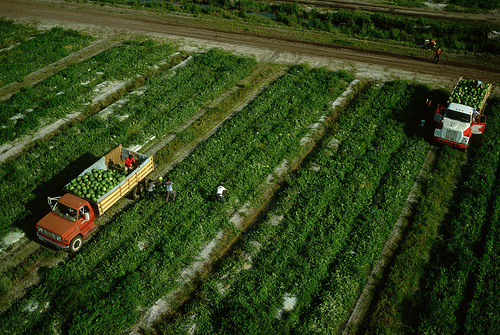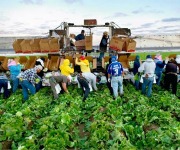 Photo: tpmartinsIn 2006, Sen. John McCain (R-Ariz.) made a now-famous declaration doubting that Americans were capable of farm labor. He dared audience members to accept a job picking lettuce for $50 per hour, insisting, even when one person accepted, “You can’t do it, my friends.” While that comment created an uproar at the time, I’m sure many people would secretly agree that most Americans don’t have the physical stamina nor the appetite for manual labor. And now, The New York Times reports that farmers in some areas of the country are discovering that very fact for themselves.
Photo: tpmartinsIn 2006, Sen. John McCain (R-Ariz.) made a now-famous declaration doubting that Americans were capable of farm labor. He dared audience members to accept a job picking lettuce for $50 per hour, insisting, even when one person accepted, “You can’t do it, my friends.” While that comment created an uproar at the time, I’m sure many people would secretly agree that most Americans don’t have the physical stamina nor the appetite for manual labor. And now, The New York Times reports that farmers in some areas of the country are discovering that very fact for themselves.
The story features John Harold, a vegetable farm owner in Colorado, who reduced the number of legal migrant workers he hired through the government’s guestworker visa program this year. He figured that with the minimum wage for guestworkers up to $10.50 (while Colorado’s minimum wage is $7.36), it would have been an attractive job for legal residents. Plus, Harold presumed that the Great Recession would provide a large pool of Coloradoans who’d be grateful for the work. He was wrong:
Six hours was enough, between the 6 a.m. start time and noon lunch break, for the first wave of local workers to quit. Some simply never came back and gave no reason. Twenty-five of them said specifically, according to farm records, that the work was too hard. On the Harold farm, pickers walk the rows alongside a huge harvest vehicle called a mule train, plucking ears of corn and handing them up to workers on the mule who box them and lift the crates, each weighing 45 to 50 pounds.
Another Colorado farm owner, Kerry Mattics, had a similar experience and decided that Americans have gotten “soft”:
“They wanted that $10.50 an hour without doing very much,” he said. “I know people with college degrees, working for the school system and only making 11 bucks.”
This is the part of the article where we decry the death of the American work ethic and discuss how most young people today would rather slouch along as bloggers or rock stars than work out in the hot sun picking sweet corn.
But all is not quite what it seems here. Reporter Kirk Johnson waits until the latter part of his piece to note that the unemployment rate in several rural Colorado counties is below 6 percent, while unemployment is higher in the state’s cities (and over 9 percent nationally). In my view the article’s headline should read “Farm Country Suffering from Labor Shortage” and not, as written by the Times‘ editors, “Hiring Locally for Farm Work Is No Cure-All.”
After all, Colorado isn’t the only state with low unemployment. Several Midwest and Great Plains farm states like Iowa (6.1 percent), South Dakota (4.7 percent), Kansas (6.7 percent), and Nebraska (4.2 percent) share that happy(ish) fate, while North Dakota clocks in at an astonishing 3.5 percent unemployment rate.
It’s fair to ask: What’s the heartland getting that the rest of country isn’t? Yes, there’s a farm boom going on — but even the Times admits that the $10.50 hourly wage for guestworkers comes in part from a general labor shortage.
And why is there a labor shortage? Blame the rise of mechanized industrial agriculture, which led to corporate consolidation of far fewer, far larger farms and a slow-but-steady depopulation of rural areas. This comes back to bite vegetable and fruit farmers particularly hard because, unlike grains or livestock, produce and fruit is still mostly picked by hand.
Perhaps the lesson here is that creating an economy designed to depopulate rural areas was unwise. And perhaps we have also learned that Americans (or guest workers) with any choice in the matter will not opt to become migrant workers, who must move from the cities to rural areas for a few months of backbreaking work during harvest time to make ends meet. That’s an awful way to run an economy by any standard.
One might think this situation would provide an opportunity to reconsider our abandonment of rural areas. But my guess is that the federal government will respond to rural labor shortages by expanding the guestworker visa program rather than by trying to find ways to get American workers back into the fields. In the abstract, that’s not necessarily a bad thing — not least because legal immigrant labor protected from abuse by the federal government and paid $10.50 per hour is far better than undocumented work done in unsafe, unhealthy conditions for less pay. And there are many potential immigrants for whom manual labor performed in a safe country with good public services is very attractive. I’d feel even better about guestworkers if they were offered a clear path to citizenship, or if farmworkers were extended the same legal protections that other workers are (they’re not, for the most part).
But let’s be clear: There are many kinds of hard manual labor — construction work, for example — that unions have helped to become paths to the middle class. So before we start claiming there’s no desire for hard work among Americans, let’s keep in mind that there’s also no desire for unions among most agricultural employers. And without unions, backbreaking work is nothing more than a path to a broken back.



